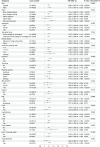Association of neutrophil to high-density lipoprotein cholesterol ratio with overactive bladder: a population-based study
- PMID: 40475997
- PMCID: PMC12137064
- DOI: 10.3389/fendo.2025.1541294
Association of neutrophil to high-density lipoprotein cholesterol ratio with overactive bladder: a population-based study
Abstract
Background: Inflammation is involved in the progression of overactive bladder (OAB). This study aimed to investigate the association between the neutrophil to high-density lipoprotein cholesterol ratio (NHR) and OAB.
Methods: Data from seven cycles of the National Health and Nutrition Examination Survey (NHANES) from 2005 to 2018 were analyzed to examine the relationship between NHR and OAB. Multivariable logistic regression model was used to estimate the association between NHR and OAB, along with restricted cubic spline regression to assess the dose-response relationship. Additionally, subgroup analyses were conducted.
Results: Among 29,315 participants, 5,815 had OAB. After covariate adjustment, we found that NHR was positively associated with the odds of OAB. Notably, the relationship between NHR and OAB was nonlinear. There was a threshold at NHR = 2.85. When NHR < 2.85, no significant association was observed; when NHR ≥ 2.85, a positive association emerged. Subgroup and interaction analyses further revealed that the link between NHR and OAB was stronger in obese participants.
Conclusion: Our results indicate a nonlinear association between NHR and OAB. When NHR is ≥ 2.85, there is a strong positive association between NHR and the odds of OAB. The interaction between obesity and NHR further increases the prevalence of OAB. Prospective and multicenter studies are needed in the future to elucidate the potential mechanism underlying the association between NHR and OAB and determine the causal relationship.
Keywords: NHANES; cross-sectional study; inflammation; neutrophil to high-density lipoprotein cholesterol ratio; overactive bladder.
Copyright © 2025 Zhang, Xu and Chen.
Conflict of interest statement
The authors declare that the research was conducted in the absence of any commercial or financial relationships that could be construed as a potential conflict of interest.
Figures




Similar articles
-
Association between novel inflammatory markers and overactive bladder: a cross-sectional study of NHANES 2009 to 2018.BMC Urol. 2025 Apr 8;25(1):78. doi: 10.1186/s12894-025-01743-5. BMC Urol. 2025. PMID: 40197316 Free PMC article.
-
The association between neutrophil to high-density lipoprotein cholesterol ratio and gallstones: a cross-sectional study.BMC Public Health. 2025 Jan 14;25(1):157. doi: 10.1186/s12889-025-21392-5. BMC Public Health. 2025. PMID: 39810139 Free PMC article.
-
Association between neutrophil-to-high-density lipoprotein cholesterol ratio and metabolic dysfunction-associated steatotic liver disease and liver fibrosis in the US population: a nationally representative cross-sectional study using NHANES data from 2017 to 2020.BMC Gastroenterol. 2024 Sep 5;24(1):300. doi: 10.1186/s12876-024-03394-6. BMC Gastroenterol. 2024. PMID: 39237899 Free PMC article.
-
Association between high-density lipoprotein-related inflammation index and periodontitis: insights from NHANES 2009-2014.Lipids Health Dis. 2024 Sep 28;23(1):321. doi: 10.1186/s12944-024-02312-9. Lipids Health Dis. 2024. PMID: 39342327 Free PMC article.
-
Association between the neutrophil-to-high-density lipoprotein cholesterol ratio with kidney stone risk: a cross-sectional study.Front Endocrinol (Lausanne). 2025 Feb 3;16:1523890. doi: 10.3389/fendo.2025.1523890. eCollection 2025. Front Endocrinol (Lausanne). 2025. PMID: 39963279 Free PMC article.
References
-
- Nambiar AK, Arlandis S, Bø K, Cobussen-Boekhorst H, Costantini E, de Heide M, et al. . European association of urology guidelines on the diagnosis and management of female non-neurogenic lower urinary tract symptoms. Part 1: diagnostics, overactive bladder, stress urinary incontinence, and mixed urinary incontinence. Eur Urol. (2022) 82:49–59. doi: 10.1016/j.eururo.2022.01.045 - DOI - PubMed
MeSH terms
Substances
LinkOut - more resources
Full Text Sources
Medical

